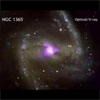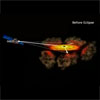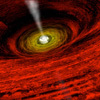CXC Home | Search | Help | Image Use Policy | Latest Images | Privacy | Accessibility | Glossary | Q&A
Optical and X-ray Images of NGC 1365
Quicktime MPEG
Beginning with the optical image of NGC 1365, the view then changes to reveal Chandra's image of the central region. The bright source in the middle of the X-ray image is generated by a disk of gas about to fall into a supermassive black hole. When a dense cloud within NGC 1365 passed in front of the black hole and disk, high-energy X-rays from the disk were blocked. This allowed astronomers to measure the size of the disk.
[Runtime: 0:10]
(Credit: X-ray: NASA/CXC/CfA/INAF/Risaliti; Optical: ESO/VLT)
Quicktime MPEG
Beginning with the optical image of NGC 1365, the view then changes to reveal Chandra's image of the central region. The bright source in the middle of the X-ray image is generated by a disk of gas about to fall into a supermassive black hole. When a dense cloud within NGC 1365 passed in front of the black hole and disk, high-energy X-rays from the disk were blocked. This allowed astronomers to measure the size of the disk.
[Runtime: 0:10]
(Credit: X-ray: NASA/CXC/CfA/INAF/Risaliti; Optical: ESO/VLT)
Illustrations of Black Hole Eclipse
Quicktime MPEG
These artist's representations, which are not to scale, explain how a supermassive black hole and the hot gas disk around it are eclipsed. The first illustration shows how light from the bright disk surrounding the black hole can directly reach Chandra. The second illustration demonstrates how this light can be blocked by a dense cloud of gas, which causes only reflected light from the disk to reach Chandra.
[Runtime: 0:15]
View Still Images
(Credit: NASA/CXC/M.Weiss)
Quicktime MPEG
These artist's representations, which are not to scale, explain how a supermassive black hole and the hot gas disk around it are eclipsed. The first illustration shows how light from the bright disk surrounding the black hole can directly reach Chandra. The second illustration demonstrates how this light can be blocked by a dense cloud of gas, which causes only reflected light from the disk to reach Chandra.
[Runtime: 0:15]
View Still Images
(Credit: NASA/CXC/M.Weiss)
Animation of Black Hole
Quicktime MPEG
This animation shows a supermassive black hole within a galaxy like the one located in NGC 1365. Scientists believe that the black hole at the center of the galaxy is fed by a steady stream of material, presumably in the form of a disk. Material just about to fall into a black hole should be heated to millions of degrees before passing over the event horizon, or point of no return. This process creates X-ray light that Chandra can detect.
[Runtime: 0:27]
Still Photo
(Animation: NASA/CXC/A.Hobart)
Quicktime MPEG
This animation shows a supermassive black hole within a galaxy like the one located in NGC 1365. Scientists believe that the black hole at the center of the galaxy is fed by a steady stream of material, presumably in the form of a disk. Material just about to fall into a black hole should be heated to millions of degrees before passing over the event horizon, or point of no return. This process creates X-ray light that Chandra can detect.
[Runtime: 0:27]
Still Photo
(Animation: NASA/CXC/A.Hobart)
Return to NGC 1365 (12 Apr 07)





